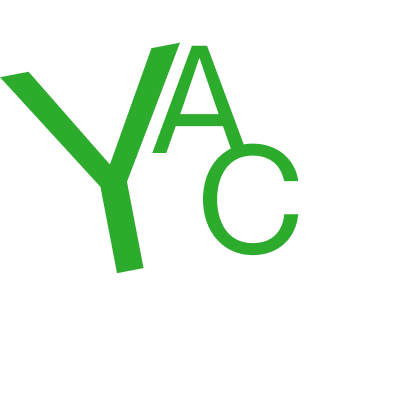Eva Masterman
Interview by David McLeavy
-
Published August 2019
-
Eva Masterman is an artist that has risen to prominance through her continual work with clay. I caught up with Eva shortly after she presented her recent exhibition Strange Comfort at Lily Brooke.
-
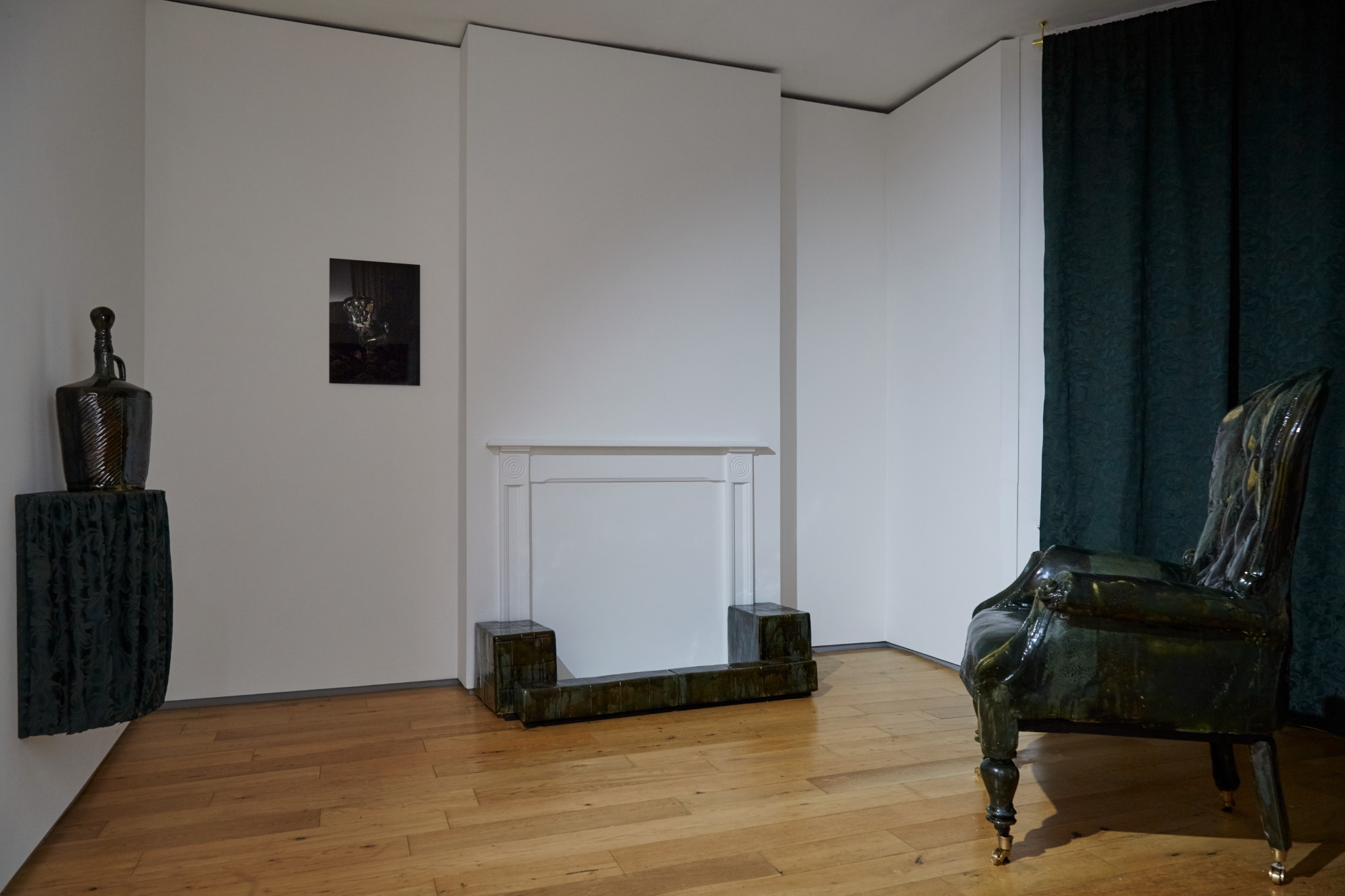 Strange Comfort, installation view, Lily Brooke, 2019. Photo by Corey Bartle-Sanderson.
Strange Comfort, installation view, Lily Brooke, 2019. Photo by Corey Bartle-Sanderson. You are fast becoming one of the most recognisable emerging artists to work primarily with clay. I want to know how you first came across the material and what it is about clay that has led you to use it so consistently over the years?
I came across clay very ordinarily really; during my BA in Kingston Upon Thames. I was obviously fairly unaware as a young art student because I went into my BA adamant that I was a painter, but once I saw the workshop I never really left. There was (and still is) an incredible artist/technician, Elaine Wilson, running the ceramic workshop there and at that point it was solely for the use of Fine Art students. It was just before the mass move of art departments to consolidate workshops from specific to general across the creative practices, so I pretty much had it to myself. Elaine was the perfect mix of technical knowledge and experimentation, so I wasn’t really given any rules to follow, just encouragement to try it out and some tips along the way to make sure whatever I was making wouldn’t explode. Ceramics is pretty temperamental; even ceramicists who have devoted 40yrs to one process will still have unexpected things happen, and this tension between skill and concept when using it in a Fine Art context is obviously a well trodden argument. What Elaine gave me was a respect for having enough understanding of the process to make sure what I’m making is structurally sound but also being flexible enough to work with whatever comes out of the kiln. There aren’t really ‘mistakes’ as far as I’m concerned, but it does bother me when bad making interferes with the concept. Some cracks you can explain away, others are just a distraction!
It’s difficult to say with any real criticality why I kept using it. Partly to do with opportunities - the residencies I went on and the studios I continued to work in outside of university all had ceramic facilities - but also sometimes I think as an artist or a maker a material can just become your primary language. There’s something about the pliability, the speed in which you can create something out of nothing that I have always enjoyed. When I use clay, there’s a palpable resistance to the material, almost like manipulating flesh. It’s a constant conversation, reacting and giving back to everything you do to it. I expect this is why a lot of people enjoy clay, it’s a very seductive material. Also, conceptually it has always made sense to me: clay has a memory in a material sense but it also is often used as a carrier of memory in a more poetic way; as souvenir, as memorial, as heirloom. It’s also something that is very close to the body, again, both when you’re making with it, using your hands directly and constantly in reference to the makers own dimensions, but also through the language of vessels (they have a foot, a lip, a body) and the intimacy in which we use ceramics on a day to day basis. We hold it and drink from it every day and that familiarity is something that I’ve always found extremely interesting.
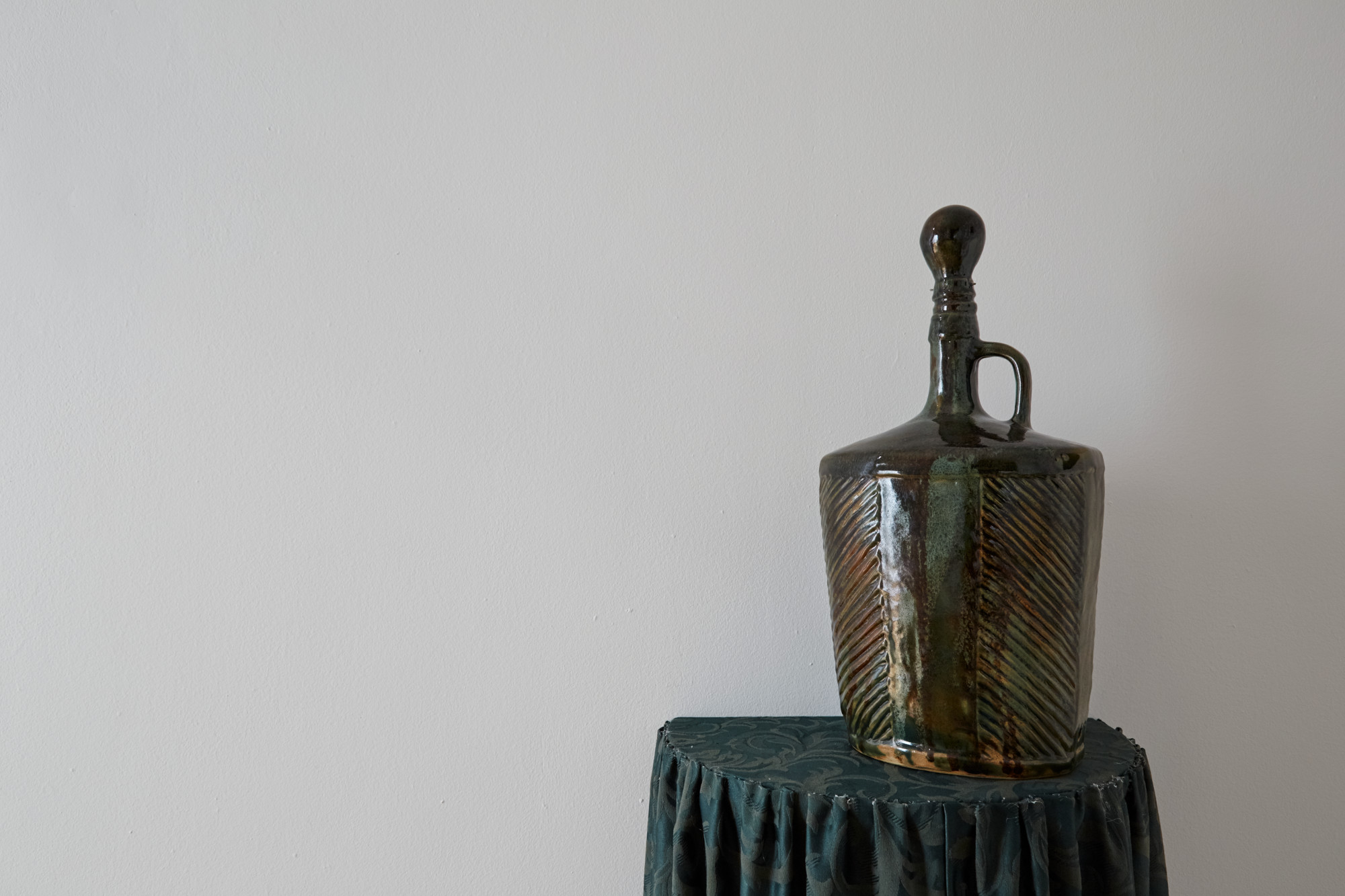 Strange Comfort, lamp, 2019, ceramic, 48x24x19cm. Photo by Corey Bartle-Sanderson.
Strange Comfort, lamp, 2019, ceramic, 48x24x19cm. Photo by Corey Bartle-Sanderson. I think people often search for the 'hand of the artist' as evidence of their interaction with the material through the development of a work of art. Perhaps looking for a fingerprint or some residue of sorts.
I am interested in the associations you make between the material and the body. I wondered if you could expand on this a little more and perhaps help me understand how this relationship may have developed over time as you have become more familiar with the material and your approach to using it?
I think there’s something inherent about the link between clay and the body; even if it’s not at the forefront of every practice, it can be such an unmediated material. You use your hands directly so, unlike with other materials where tools or machines are used, it’s shaped in relation to your body, even if you don’t mean it to be. I’m generalising because obviously lots of people use tools when working in clay (including me!), but in my practice it’s always seemed like I was trying to fill the negative space in front of me. I want to be able to wrap my arms around what I make. There’s often something very domestic about the scale of clay objects which positions them always next to the body whether you like it or not.
The work has always been about relationships and the space between people, physical or otherwise, but I’ve only begun to really understand the centrality of this in my work over the last year or so. The immediacy of the material and how easily it relates or responds to my body has always been something I’ve been drawn to, but as I’ve got used to that relationship I’ve started to look at it in a more intentional way. I use a lot of moulds and increasingly representational objects, all of which are about negatives and positives, how things fit together or are used, the space between or how they can invoke what isn’t there through voided function. I suppose it’s all increasingly about loss and trying to hold onto those ‘bodies’ that aren’t here anymore. The empty chair is a good example. It speaks of what isn’t there. Clay allows me to try and create something out of nothing, to create corporeal objects that are heavy and present but also speak of absence.
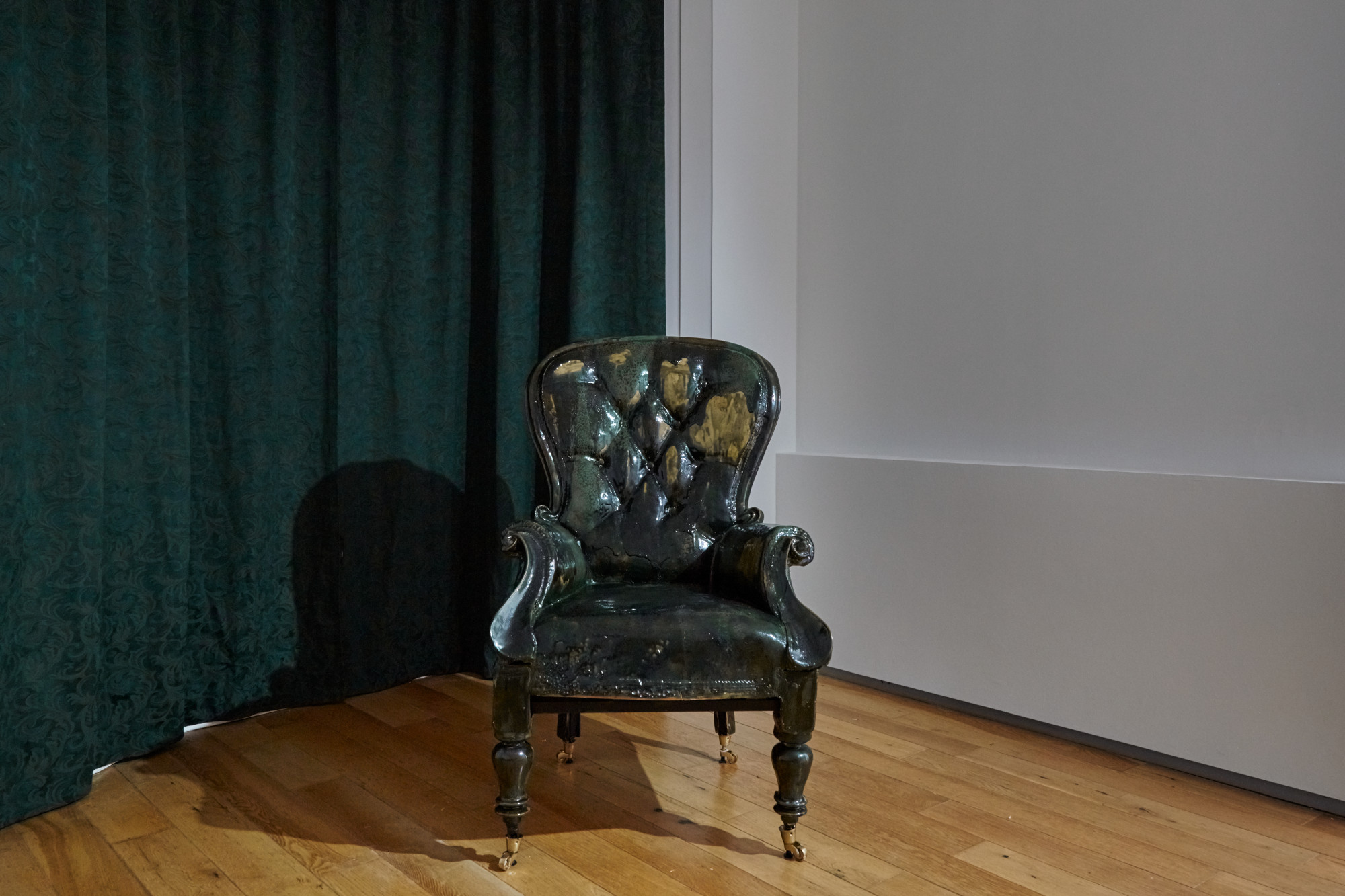 Strange Comfort, chair, 2019, ceramic, brass, steel, 120x70x70cm. Photo by Corey Bartle-Sanderson.
Strange Comfort, chair, 2019, ceramic, brass, steel, 120x70x70cm. Photo by Corey Bartle-Sanderson. I guess the vase and the chair are similar in that respect, in that they are both vessels that require someone(thing) to occupy a portion of their space in order for to fulfil it's functional intention.
I want to ask you about your recent exhibition at Lily Brooke. The work seemed to respond to and explore the domestic nature of the space and the context, which feels like a perfect marriage for your work. Could you talk a little more about how that exhibition came together?
I'd been thinking about domestic spaces for a long time before Lily offered me the show. I’d been aware of her gallery since it opened so had been in conversation with her for a while but she’d been hesitant about having exhibitions that so directly referenced the fact that the gallery is also a home. There was a feeling that maybe it was too easy a connection to make and, understandably, she wanted to define her own style as a curator without relying on the space to dictate that. I’d started reading gothic literature and watching film noir and my ideas had started to coalesce around the objects I was making as characters or props in a set of some kind that the audience would be invited into. So although it references the domestic, it actually feels for me like it’s more anchored in a film or theatre context - in a previous life I was a prop maker so have been interested in theatre and set design for quite a while anyway. About 10 months ago I moved from London to Newcastle to take the position of the Norma Lipman Fellow in Ceramics at Newcastle University. It’s an amazing opportunity - 3 years residency at the university with studio and salary! - but it was a really difficult move for many reasons. Leaving London which had been my home for 14years made me feel very displaced. Coupled with that, a lot of the older generation of my family had passed away very swiftly, so I’d been thinking a lot about place and the people that inhabited those spaces, both physically and in memory. All of this was floating around in my head and I was making these objects and trying to work out how they could exist as an installation but also have a life beyond that. By this time, Lily had offered me the show so it was really useful to be thinking about the objects in relation to a specific space, but kept feeling like there was something missing. Then there was a moment of serendipity that allowed me to explore film and photography for the first time. I gained access to a vacant house with this amazing 60s, Shining-esque decor, and collaborated with a colleague at Newcastle, Henry Coombes, who specialises in film noir filming techniques, to take the chair into that space and have a day of filming and photography. It all just kind of came together, using framing to enhance the narrative and the sense of absent people that I’d been keen to explore. And then whilst the exhibition was on, we also hosted a murder mystery in the space, so it was literally used as a set for an evening. It’s been a really important experience for me, giving me a freedom to try new things and experience the work in new ways.
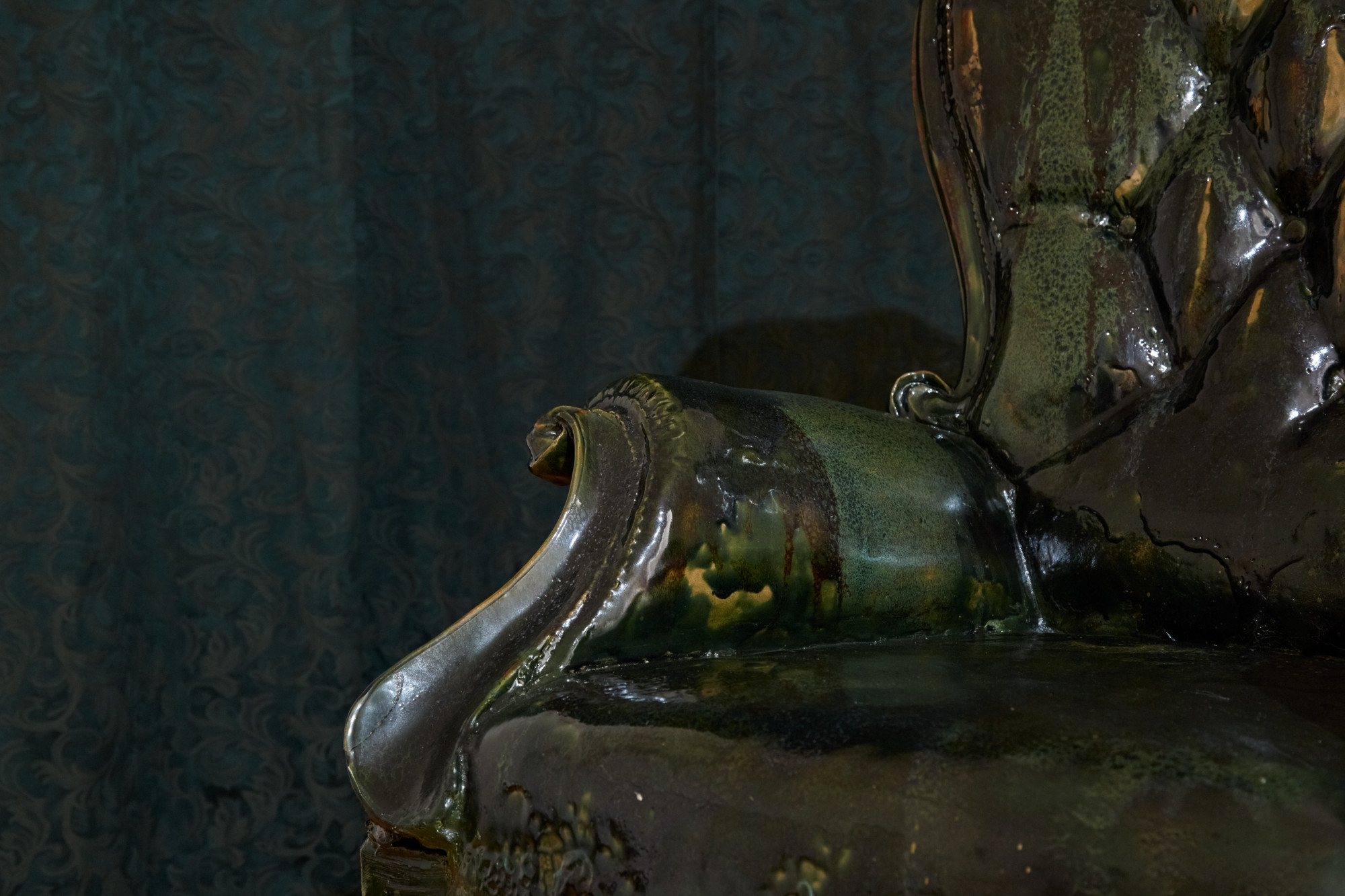
Strange Comfort, chair, detail view, 2019, ceramic, brass, steel, 120x70x70cm. Photo by Corey Bartle-Sanderson.
It's nice to hear you describe the balance of pre planning and elements of serendipity, as in my experience it feels both are in a constant dance with one another in the preparation of shows and the development of projects. I want to talk a little more about scale and how you approach the challenge of working with both large scale ceramic works and much more familiar sized pieces. Is playing with scale important to you?
I totally agree, you have to be flexible when putting on exhibitions, so much can change when you actually get into the space. Those last few days when the work starts to come together for me are always the most exciting and usually when the final big changes are made. Makes for a bit of a nervous time for the curator, but it usually turns out alright!
In regards to scale, I’ve always enjoyed making big things, so I’ve consistently tried to orchestrate opportunities to facilitate large scale work. Obviously when you’re working in clay, you’re fairly limited to the size of your kiln, so if you’re not careful, everything you make comes out more or less the same size. Although the objects I make are created autonomously, they are conceived in relation to each other and mostly presented in groups or pairs; I always try and keep a rhythm of scale going, so I can fill a space with objects that look random or collected whilst at the same time related through uniform colour or surface, like putting a filter over the scene. As the work is increasingly representational, there’s also a consideration as to whether I stick to the original scale or whether I push it bigger or smaller to displace the familiarity; those decisions tend to be pretty intuitive. I wouldn’t necessarily call it ‘playing’ but it’s definitely an ongoing consideration - I make something, stand back, put it next to something else and make something that fits into the spaces between.
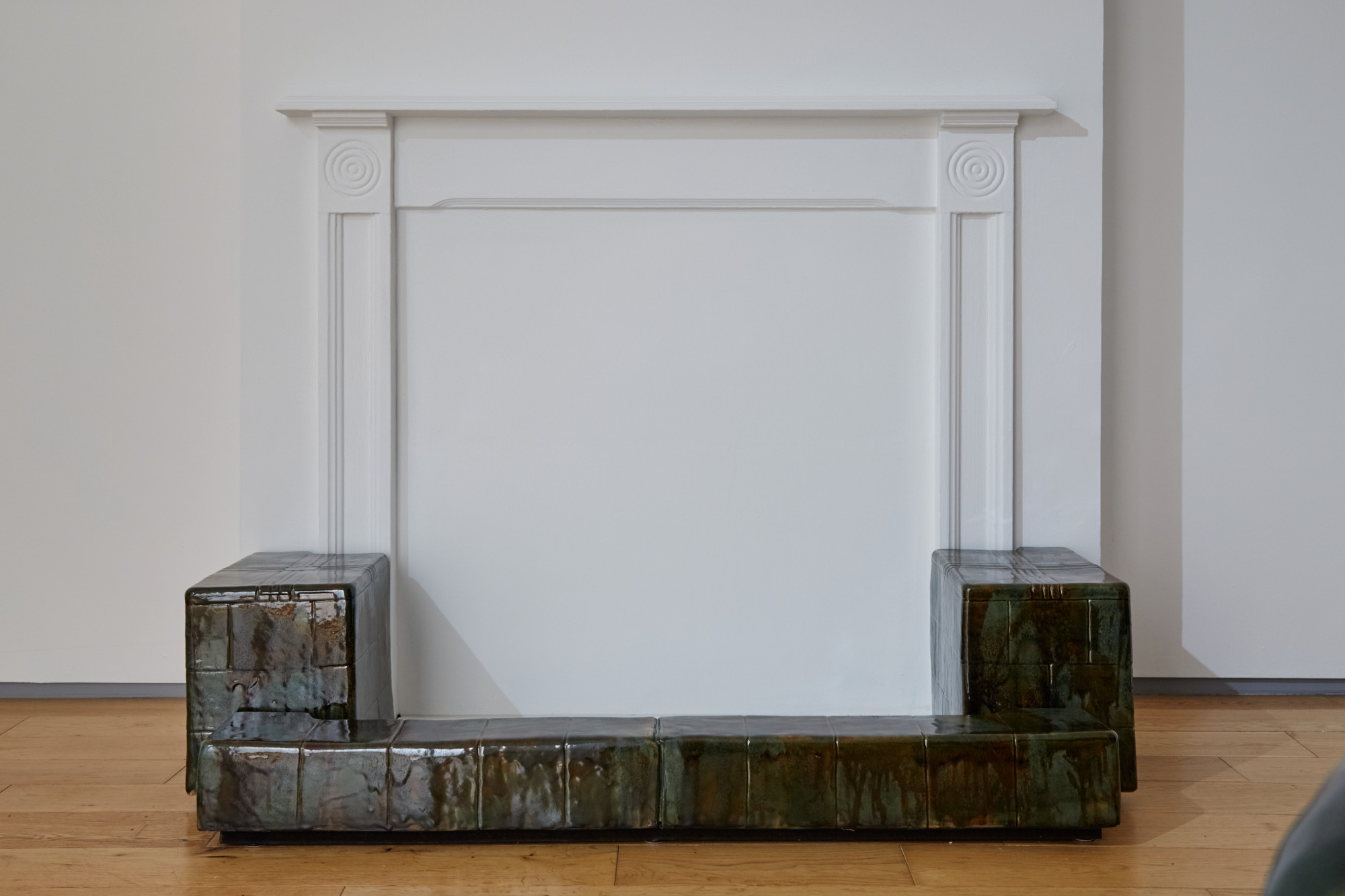 Strange Comfort, fire surround, 2019, ceramic, 28x135x52cm. Photo by Corey Bartle-Sanderson.
Strange Comfort, fire surround, 2019, ceramic, 28x135x52cm. Photo by Corey Bartle-Sanderson. I want to return to something you mentioned previously, in that you have fairly recently become the Norma Lipman Fellow in Ceramics at Newcastle University. Has this residency/fellowship altered your practice in any way and can you see the impact of your presence in the work of the students currently studying within the fine art department?
I’m not sure ‘altered’ is the correct word, it’s certainly opened it up though. As I mentioned, I was living in London for about 11yrs after graduating my BA and it’s a pretty obvious thing to say, but London living is really expensive and busy! Especially after I finished my Masters the three years after that were particularly hectic: I co-founded a clay-orientated social practice collective, Collective Matter, and set up a communal clay workshop at Sugarhouse Studios in Bermondsey with Assemble, which took up a lot of time and energy. It was, and still is, an incredible thing to be part of and with the crisis in art education, my founders and I all think it's important to be part of that conversation: it still makes up about half of my extended work. But when we started and I was still in London, the pressure of having to make rent on top of that meant that I really didn’t have much time for my own studio practice. Or at least not much headspace for it. Living in London and being an artist in general is a very precarious and reactive life, I found it very difficult to give myself space to just pause and reflect. So what Newcastle has afforded is the time to create a more sustainable practice and the space around that to experiment and try things I wouldn’t before. I’ve always written and taught and made things and collected images and objects, but now I can really start to put all of that together in a much more conscious way. Being attached to a university is also just pretty amazing, having daily access to everything from plasma cutters to filming suite to 6ft kilns is a dream. It makes making anything so much easier!
As for the students, I really do see teaching as part of my extended practice - it takes up so much time it would be silly not to. The work I do with Collective Matter is all centred around alternative learning and providing professional, material led opportunities for other artists and the public, so working with the students all feeds back into that. There’s been a rising interest in clay in fine art over the last 10yrs or so, and when I got here there were quite a few making with clay already. Andrew Burton and Katie Cuddon are both senior academics here, and the Norma Lipman Fellow has been running for about 10yrs or so too, so 'fine art clay' is part of the foundations of Newcastle. But I do try and make myself accessible to the students, and I think they’re excited to have someone they can ask about practical things as well as conceptual. Too often I feel those things are kept separate, so I’m enjoying filling a role that sits in-between.
Whats next for you?
I’ve been making a point of trying to be a bit more present in general and just enjoy the stability of being in Newcastle, so what’s next will hopefully be lots of time in the studio! I have a solo show coming up in December at the Ex Libris Gallery at Newcastle University which be a development of the work shown at Lily Brooke, and I’m hopeful that will lead to more opportunities up there. I’m also designing an opera set in collaboration with the music department and organising a conference in April on the ceramic archives at The Shipley Gallery, Gateshead. It maybe sounds a bit boring but I’m really just looking forward to having some time in the UK and the studio, I’ve spent so much time travelling and putting my energy into other things the last few years. I want to start bringing in more material languages of theatre sets, play with collage and scale a bit more and am really excited to see where the film and photography takes me too. So watch this space I guess!
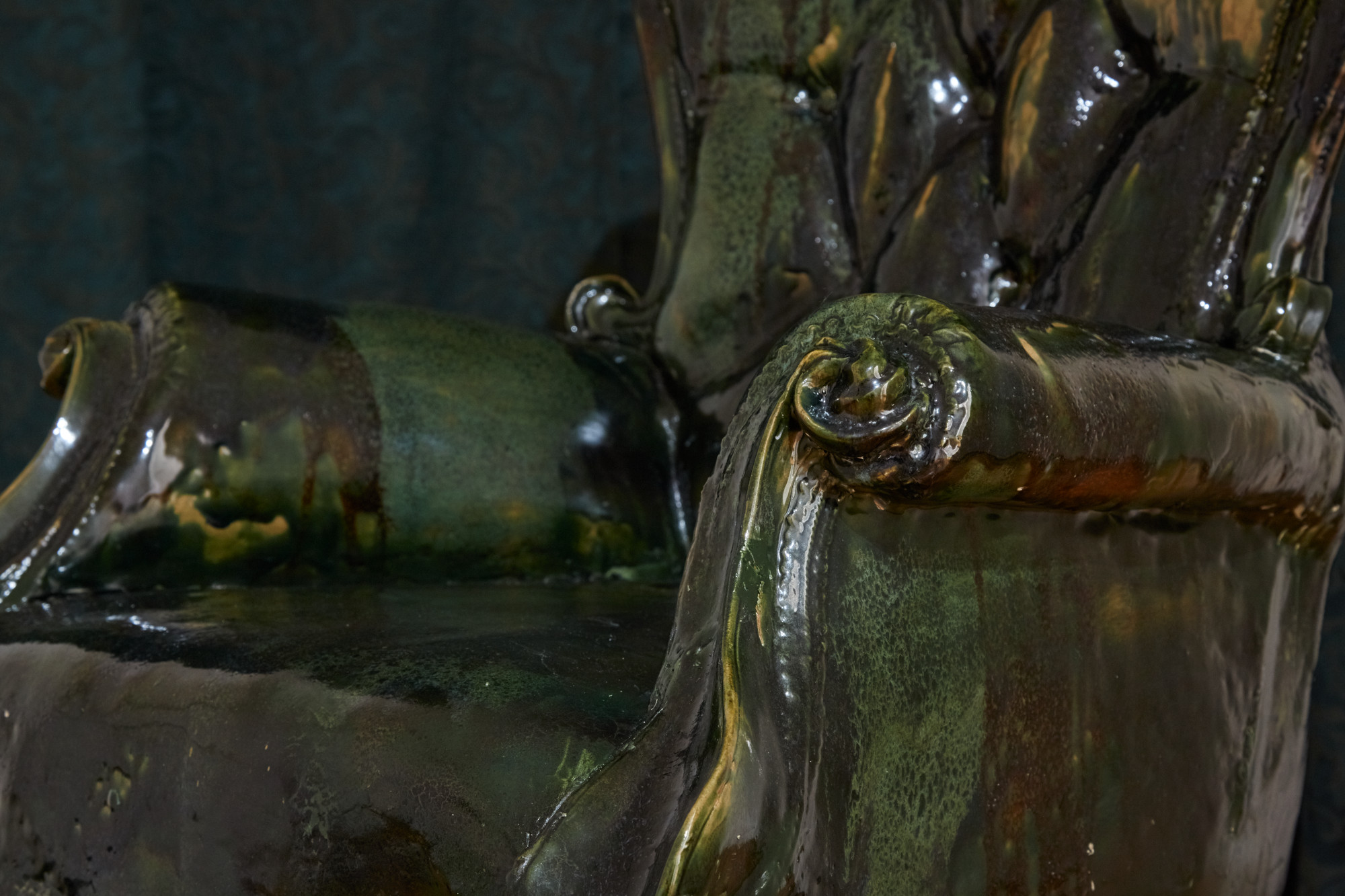
Strange Comfort, chair, detail view, 2019, ceramic, brass, steel, 120x70x70cm. Photo by Corey Bartle-Sanderson.
-
evamasterman.com/
-
If you like this why not read our interview with Tom Cardew
-
© YAC | Young Artists in Conversation ALL RIGHTS RESERVED
